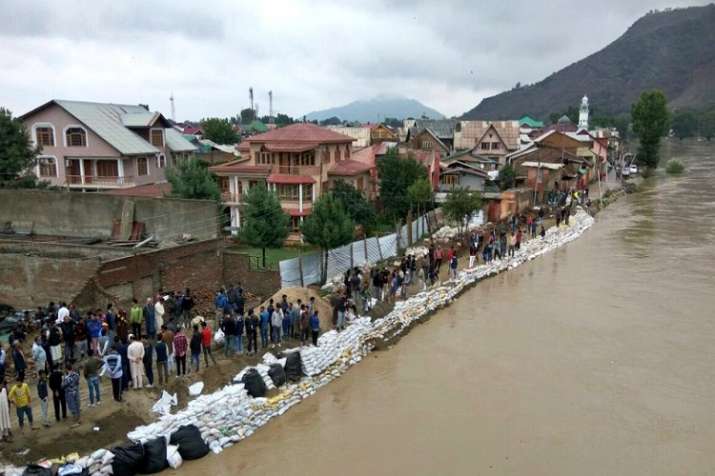
Srinagar- The irrigation and flood control (I&FC) department has issued flood duty chart to its staff, besides acquiring over one lakh sand bags to plug weak spots along Jhelum river and its tributaries to prevent any imminent threat of floods in the Kashmir Valley.
Despite no looming threat of flood situation, the I&FC department has carried out a safety audit of Jhelum embankments and identified the weak spots, the officials said. The audit, they said, was conducted last month as part of the department’s advanced planning in meeting any possible flood situation.
Executive Engineer I&FCD, Srinagar Ajaz Ahmad Keen told Kashmir Observer that they will keep over one lakh sand bags ready at different weak spots to block the flood threat if any.
“We have started the tendering process for the sand bags and it will be completed within days,” he said.
He further added that the department has issued the flood duty chart for the employees and they will be deployed to the specific areas.
“In this regard we had a meeting with Divisional Commissioner Kashmir and his orders will be implemented within the coming days,” he added.
It may be noted, the Divisional Commissioner Kashmir Pandurang K Pole on April 9, chaired a meeting of officers of various departments to review the preparation by respective departments to tackle flood situations and mitigate its effect.
The officials told Kashmir Observer that the Div Com directed I&FC and Indian Meteorological Department to issue forecasts of rainfall and flood alerts on a timely basis for dissemination to responding departments, officers from civil administration and police, and public through electronic, print and digital media.
“The Div Com stressed that flood warning should be provided well in advance so the hazard shall be mitigated,” the official said.
He also said that the department is compiling a database of maps of Jhelum, its tributaries and catchment areas for monitoring water level and rescue & evacuation process as directed by the Div Com.
The official said that on the directions of Div Com, the department is marking the 2014 flood level on bridges and government buildings so people would remain alert every time they respond to a flood situation.
Deputy Director MeT department, Mukhtar Ahmad told Kashmir Observer that they have already updated the database on their website which can predict flood threat in advance.
The Valley has been witnessing continuous rainfall and thunderstorms since last week raising level in water bodies.
Ahmad said that the light to moderate rain with thunder scattered to fairly widespread places over Kashmir Division is expected during 19th evening to 21th April forenoon.
It may be noted that after the 2014 deluge, the government had announced that dredging of river Jhelum would be completed by December 2016 to prevent floods in future. However, the dredging is yet to be completed.
The dredging of Jhelum was to be carried in two phases to increase its carrying capacity. However, the concerned company missed several deadlines for the phase I as a result phase II is yet to be started, sources told Kashmir Observer.
“We were also awaiting release for funds from the central government for phase II and the same was approved. We are in the process of tendering and it will be completed soon,” the official said.
Keen told Kashmir Observer that the Srinagar city, which was the worst hit in 2014 deluge, doesn’t need the dredging as of now.
“The department will conduct the dredging in lower areas like Hokersar wetland, Baramulla, Sopore and Bandipora in Phase II,” Keen said, adding that “when the water flow will go towards lower areas then we will carry the dredging in the city,”
He said the carrying capacity of the water in the Jhelum was 3300 Cusecs and with the completion of Phase I it has been enhanced to 41000 Cusecs.
“When phase II will be completed, the carrying capacity will be 60000 Cusecs,” he added.
Follow this link to join our WhatsApp group: Join Now
Be Part of Quality Journalism |
Quality journalism takes a lot of time, money and hard work to produce and despite all the hardships we still do it. Our reporters and editors are working overtime in Kashmir and beyond to cover what you care about, break big stories, and expose injustices that can change lives. Today more people are reading Kashmir Observer than ever, but only a handful are paying while advertising revenues are falling fast. |
| ACT NOW |
| MONTHLY | Rs 100 | |
| YEARLY | Rs 1000 | |
| LIFETIME | Rs 10000 | |










